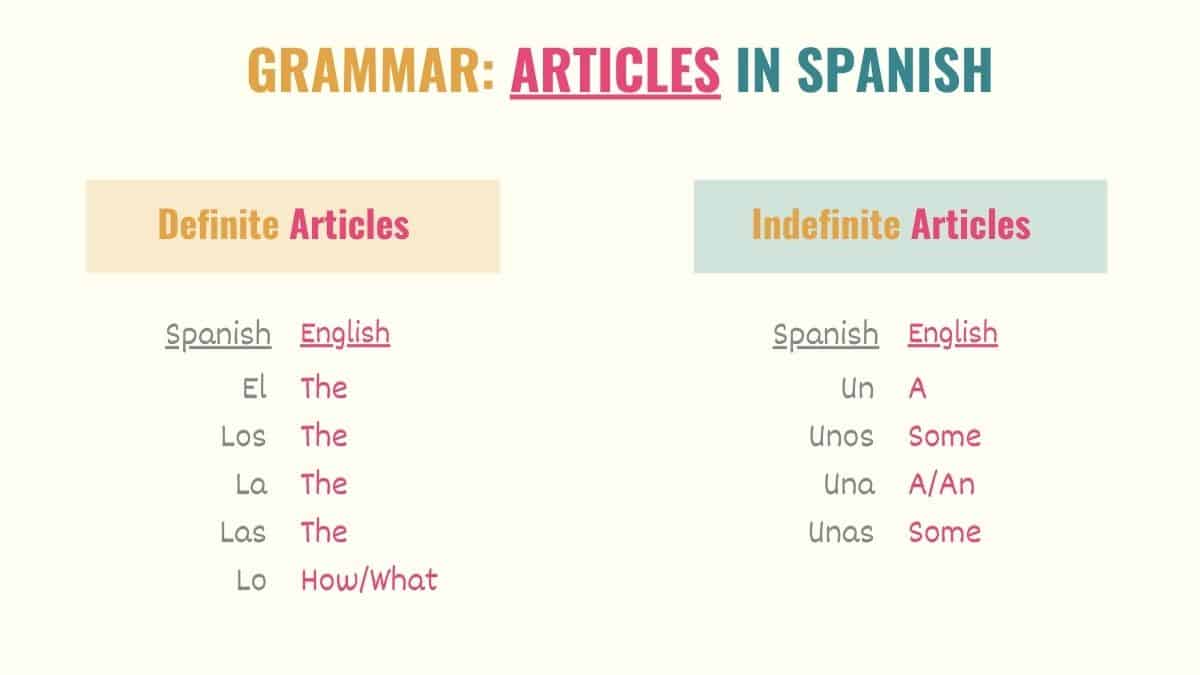According to the Royal Spanish Academy’s most recent corpus, the articles la and el are the second and the fourth most used words in Spanish, respectively. So, if you ever wonder if articles in Spanish are important, the answer is without a doubt, yes!
Articles are key to forming cohesive sentences in Spanish. So, if you’re looking to learn more about this essential topic, in this guide, you’ll find all the crucial information you need to understand and adequately use Spanish articles.
Here is a quick overview of the topics covered in this guide:
- What Are Articles?
- Definite Articles in Spanish
- Indefinite Articles in Spanish
- Difference Between Definite & Indefinite Articles
- Spanish Articles and Spelling Considerations
- When Not to Use Articles?
- Key Points About Spanish Articles
By the end of it, you’ll feel more confident about articles in Spanish.
What Are Articles in Spanish?
Articles are small words that are classified as determiners. In simple terms, this means that Spanish articles are words that you place before a noun to provide certain details about the thing or person you’re talking about. When using Spanish articles, you convey the following information:
- The gender and number of the noun (feminine or masculine, singular or plural).
- If the people involved in the conversation already know or are aware of the specific object you’re talking about.
Confused? Check these examples:
Siempre sí compré el celular.
I ended up buying the phone.
Ayer compré unos celulares.
Yesterday, I bought some phones.
If you compare example #1 vs. #2, you’ll realize that they’re talking about masculine nouns. However, #1 refers to a single phone, while #2 talks about multiple phones.
Additionally, by using el, the first example implies that the people involved in the conversation already know which phone I’m talking about. This doesn’t happen in the second example, where people don’t know anything about the types of phones I got.
Based on their degree of specificity, articles in Spanish are classified into:
- Definite articles: to refer to defined objects or people.
- Indefinite articles: used to talk about undefined people or things.
In the sections below, we’ll explore these types of articles in more detail.
Spanish Definite Articles
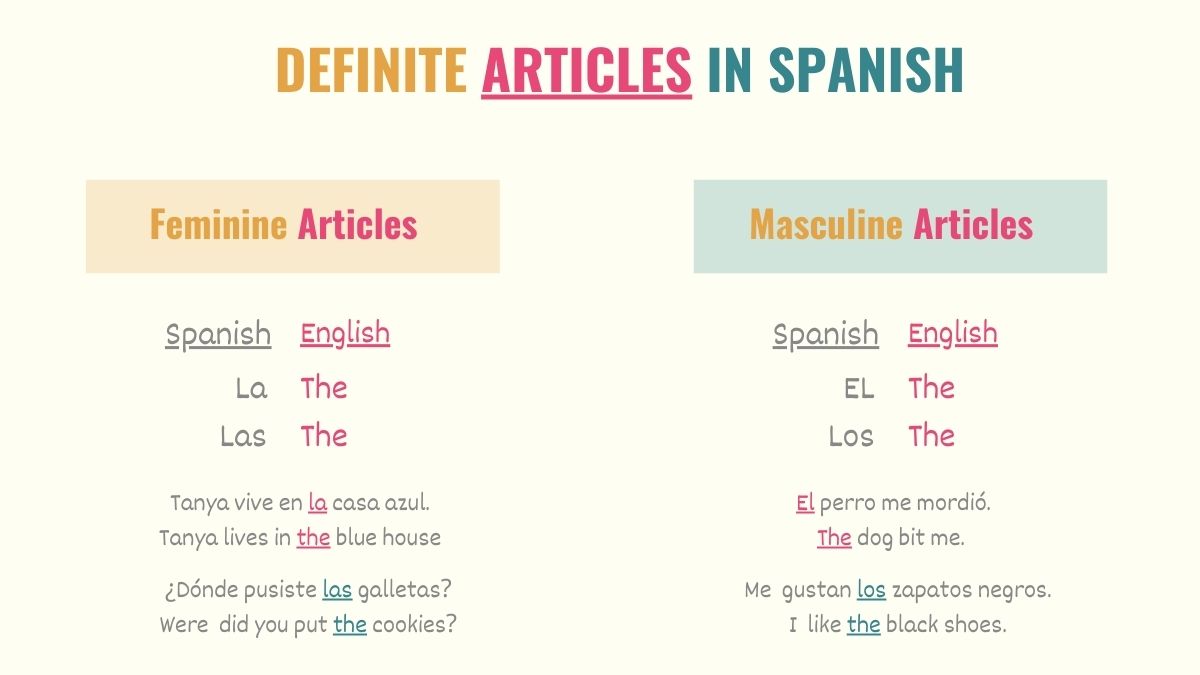
As their name suggests, definite articles in Spanish work with a defined noun. This means that the people engaging in the conversation with you already know or have heard about the noun you’re talking about.
So, in simple terms, you use definite articles to talk about particular things you previously mentioned and that you know people will be able to identify. Below is a table with definite articles in Spanish:
| Spanish masculine definite articles | English equivalent |
|---|---|
| El | The |
| Los | The |
| Spanish femenine definite articles | English equivalent |
|---|---|
| La | The |
| Las | The |
When to use definite articles
Identifying when you’re talking about something specific can be challenging as a new Spanish learner. So, if you still feel unsure about when to use definite articles in Spanish, here is a list of situations where you need to use these words:
- To describe specific objects or people.
- To tell the time in Spanish.
- To emphasize that something is unique or the best of its kind.
- To talk about games, days of the week, instruments you play, ordinary numbers, body parts, dates, and sports.
- To express your likes and dislikes.
- To build superlative sentences in Spanish.
- To refer to people’s titles or certain names of places.
- To refer to objects that are near the speaker.
Take Note: When the prepositions a or de come immediately before the article ‘el’, you need to contract both words (check the graphic below) to avoid awkward pronunciation.
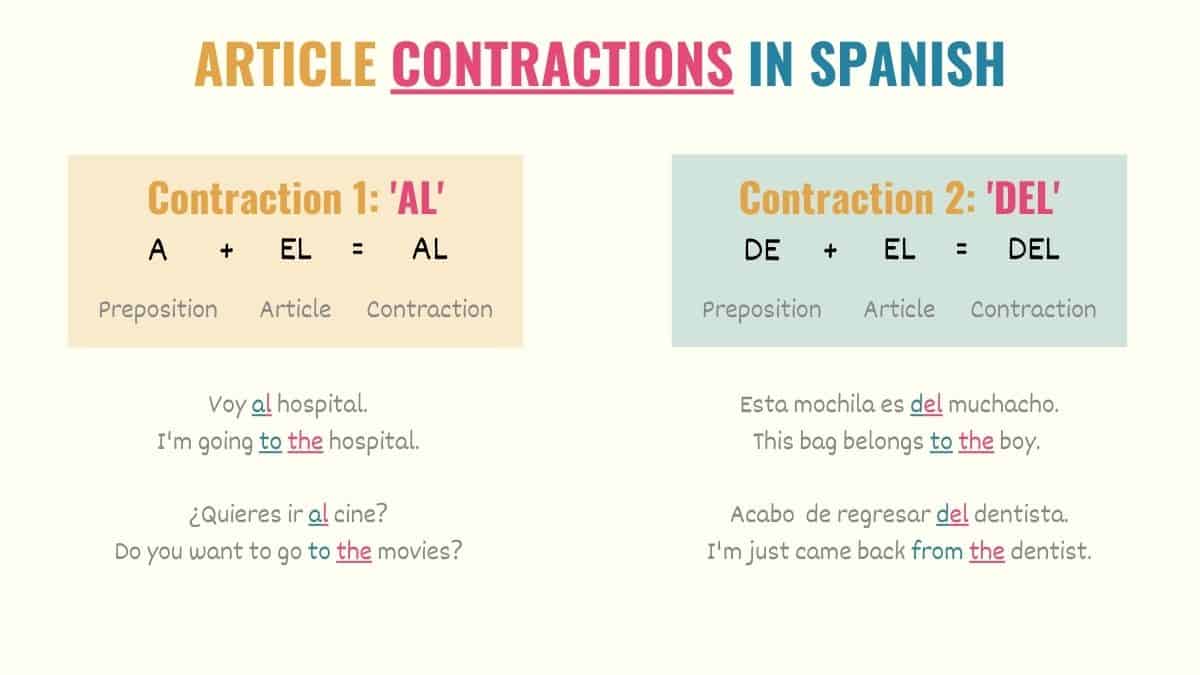
Examples of how to use definite articles in Spanish
Below are some examples of how to use definite articles in Spanish. Let’s see if you can identify all of the contexts listed above, shall we? Remember that these words need to agree in gender and number with the noun.
[Definite Article] + [noun]+ (complement)
No me gustó el pastel.
I didn’t like the cake.
Tengo clase los lunes.
I have classes on Mondays.
Tip: While we don’t do this in English, we always a masculine article (‘el’ or ‘los’) to refer to the days of the week in Spanish.
Creo que son las cinco.
I believe it is five.
Celia se quebró el brazo.
Celia broke her arm.
Tip: In English, you don’t use articles with the same frequency as we do in Spanish. As a result, there will be many situations that may seem weird to you. For example, body parts always work with definite articles because they’re something unique and specific.
La casa de la esquina es azul.
The house on the corner is blue.
¿Sabe a qué hora llega la doctora?
What time does the doctor arrive?
Tip: In this example, we know that the doctor is female. If the doctor was male, we would use ‘el doctor’.
Juan Carlos toca la guitarra muy bien.
Juan Carlos plays the guitar very well.
Mis primos son los más altos de la familia.
My cousins are the tallest in the family.
Judith y Tony se mudaron a La Habana.
Judith and Tony moved to Havana.
Pasa, Charlie, ¿puedes cerrar la puerta?
Come in, Charlie. Can you close the door?
Ella es siempre la mujer para Sherlock Holmes.
She was always the woman for Sherlock Holmes.
Tip: In Spanish, there are many places (such as countries, rivers, cities, mountains, lakes, etc.) whose name is formed with a definite article. Some examples include:
| Spanish Name | English Equivalent |
|---|---|
| La Habana | Havana |
| La India | India |
| El Paso | El Paso |
| El Cairo | Cairo |
| El Amazonas | The Amazon |
| El Salvador | El Salvador |
| El Himalaya | Himalayas |
| Los Países Bajos | Netherlands |
Advanced Tip: Spanish speakers use definite articles to express possession as well. This meaning is only available when it’s more than clear that the object belongs to the speaker. In this case, you can use articles instead of possessive adjectives.
As a result, you could say:
Me robaron el celular y la cartera.
Somebody stole my phone and my wallet.
Neuter article ‘lo’
As you progress in your Spanish grammar, sooner or later, you’ll have to use the infamous neuter article lo. Jokes aside, many students assume that ‘lo’ is a masculine article. However, as a neuter article, ‘lo’ does not convey the gender of a noun.
Unlike other Spanish definite articles, ‘lo’ only has this form and it doesn’t work with nouns because Spanish nouns always have a gender. As a result, the neuter article ‘lo’ is used to:
- Emphasize qualities.
- Refer to abstract concepts, such as ideas, wishes, or thoughts.
When working as a neuter article, lo can be translated as ‘how’ or ‘what’. Keep in mind that we use the conjunction que to introduce ideas, wishes or thoughts.
Lo + [adjective/adverb/que] + [complement]
No puedo creer lo rápido que comes.
I can’t believe how fast you eat.
Lo que quiero es descansar.
What I want is to rest.
Ojalá pudieras ver lo bonita que está la ciudad.
I wish you were able to see how pretty the city is.
Take Note: Some people also use the neuter article ‘lo’ to refer to a person’s house or commercial business. While this application is not as common as it used to be, you may find it in books or in small towns.
Ahorita vengo. Voy a lo de Sophie.
I’ll be right back. I’m going to Sophie’s.
Indefinite Articles in Spanish
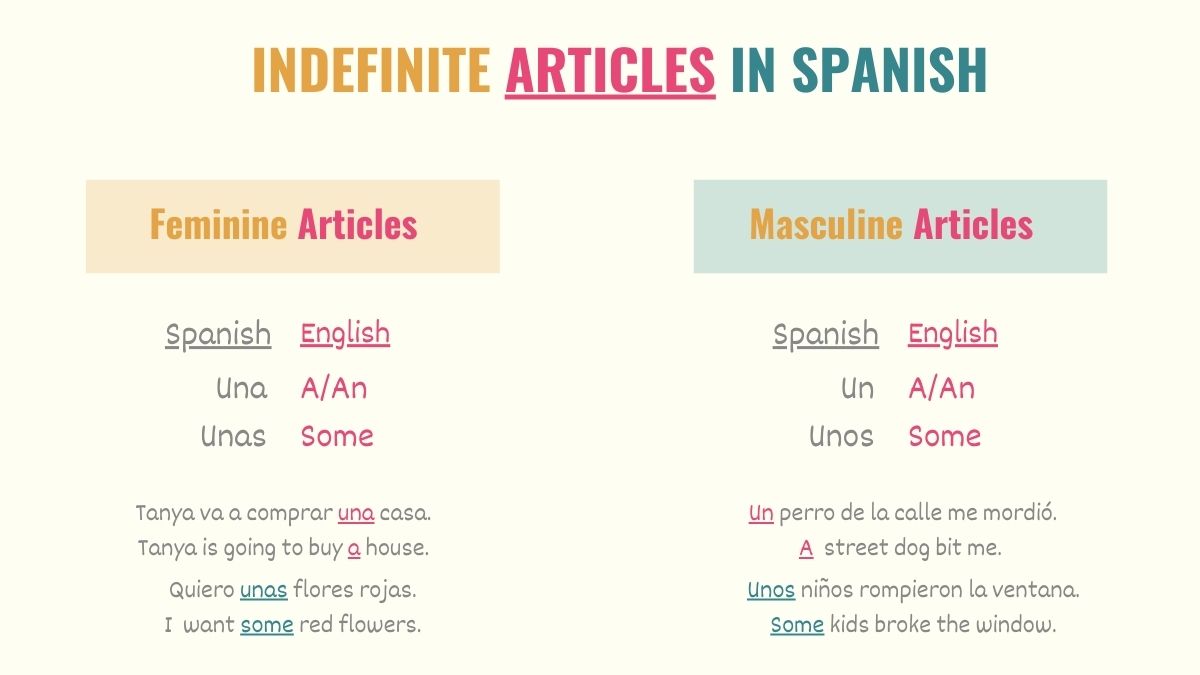
Spanish indefinite articles refer to imprecise and undefined people or things. This means that the listener or reader is not yet aware of the noun (object) you’re referring to, or he doesn’t have enough information to identify it.
For this reason, indefinite articles in Spanish are used to introduce a person or object into the conversation. Below is a table with all the indefinite articles in Spanish:
| Spanish masculine indefinite articles | English equivalent |
|---|---|
| Un | A/An |
| Unos | Some |
| Spanish feminine indefinite articles | English equivalent |
|---|---|
| Una | A/An |
| Unas | Some |
When to use indefinite articles
Spanish indefinite articles have three main uses:
- Refer to an unspecified noun.
- Express and emphasize the amount of a noun.
- Emphasize the qualities or characteristics of a noun.
Here are some examples of how to use these articles:
[Subject] + [verb conjugated] + [indefinite article] + adjective) + [noun]
Te compré un suéter.
I bought you a sweater.
Jonathan, ¿quieres una manzana?
Jonathan, do you want an apple?
Quiero un helado de chocolate.
I want a chocolate ice cream cone.
Tatiana es una buena hermana.
Tatiana is a good sister.
Hay unos niños en la puerta.
There are some kids at the door.
As you can see in examples #1 and #5, we don’t have much information about the nouns. We don’t know who those kids are or what type of sweater I bought you. On the other hand, examples #2 and #3 express the quantity of ice cream and apples the person wants. Finally, the fourth example emphasizes Tatiana’s characteristics.
Difference Between Definite & Indefinite Articles
As you have learned so far, definite and indefinite articles in Spanish aren’t the same. The key difference between these sets of words is their degree of specificity. To put it in simple terms:
- Definite articles accompany defined nouns that listeners can easily distinguish because they’ve heard or known about them before.
- Indefinite articles work with undefined nouns that listeners cannot identify because they either don’t have enough information about that noun or haven’t heard about it.
Check these simple examples:
Definite article
Quiero el pastel de chocolate, por favor.
I want the chocolate cake, please.
Indefinite article
Quiero un pastel, por favor.
I want a cake, please.
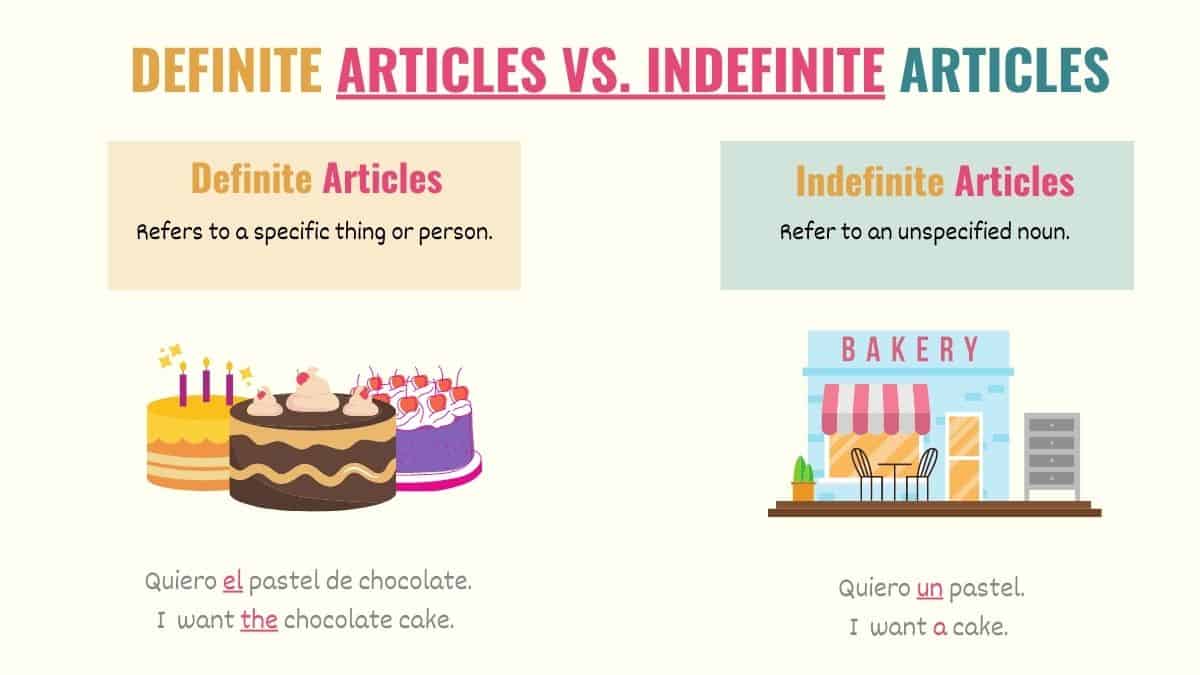
Observe the sentences above. When using definite articles, I’m talking about something specific that the listeners can quickly identify. In this example, that would be the chocolate cake, and it’s implied that the person selling cakes knows what cake I’m talking about.
However, if I use the indefinite article, aside from the quantity, I’m not giving much information about what I want. So, the clerk and I would need to have a conversation to define the type of cake I’m looking for.
Take Note: Another key difference between definite and indefinite articles in Spanish is that definite articles never work with the verb haber. This use is only applicable to indefinite articles.
Incorrect:
Hay la rebanada de pizza en la mesa.
There’s the slice of pizza on the table.
Correct:
Hay una rebanada de pizza en la mesa.
There’s a slice of pizza on the table.
Spanish Articles and Spelling Considerations
We’ve already established that Spanish nouns always have a gender and that you have to choose the article that agrees with the object’s gender. However, when it comes to Spanish articles, there’s an exception to this rule that you should know.
When a feminine singular noun begins with a stressed ‘a’ sound, you will have to use a singular masculine article to ease the pronunciation.
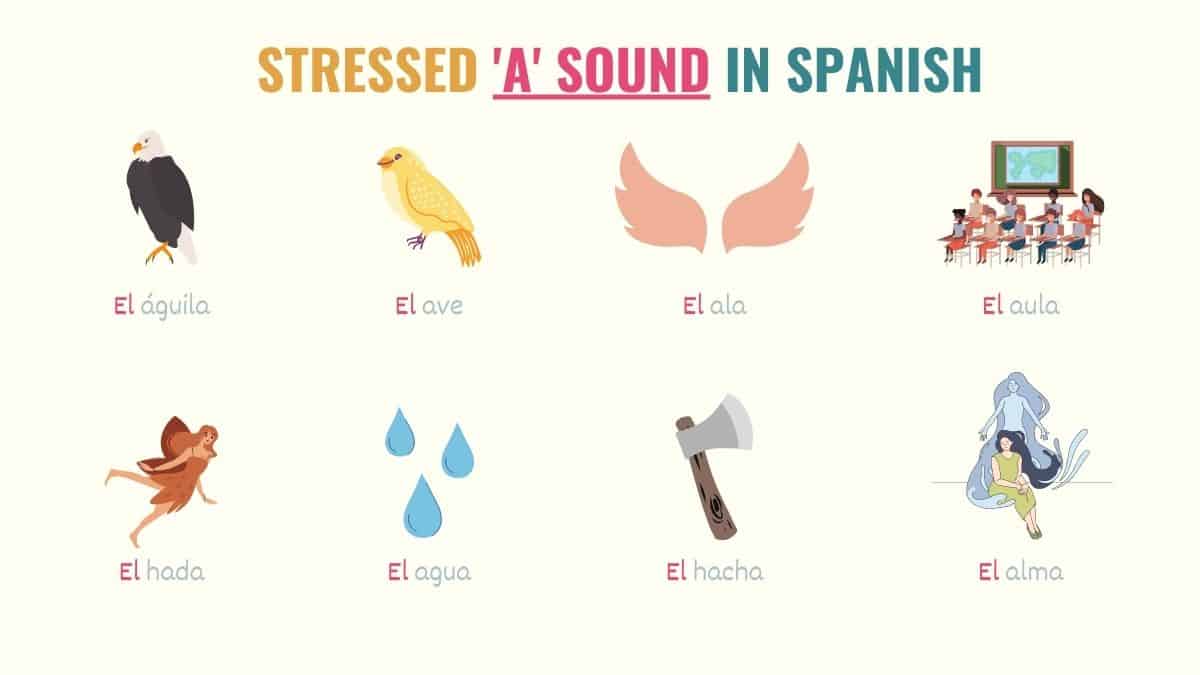
Want to check it for yourself? Try to read the sentences below. Did you notice how smooth the pronunciation is with the correct examples?
| Incorrect | Correct |
|---|---|
| ¡Mira! Una águila | ¡Mira! Un águila |
| ¿Dónde está la agua? | ¿Dónde está el agua? |
| La hada de los dientes no vino. | El hada de los dientes no vino. |
This rule doesn’t apply if:
- There’s an adjective between the article and the noun.
- The noun is in its diminutive form or other variations.
- The article is used to establish the gender of a noun.
- The noun refers to the name of a letter or initials.
Check these examples:
[Article] + (adjective) + [noun]
La pequeña hada voló a su casa.
The little fairy flew to her house.
Vimos una aguilita en la montaña.
We saw a little eagle on the mountain.
Mi comida favorita es la árabe.
My favorite food is Arabic.
En español, la hache es muda.
In Spanish, the letter H is mute.
When to Omit Articles in Spanish?
Although they are a common element in a sentence, articles in Spanish have to be omitted in certain situations. The following cases do not require the use of articles:
- Saying a person’s profession
- Referring to months or years
- Referring to proper nouns
- Talking about uncountable nouns or unspecified amounts
Here are some examples:
Incorrect:
Lenny es un enfermero.
Lenny is a nurse.
Correct:
Lenny es enfermero.
Lenny is a nurse.
Incorrect:
Bonnie es una periodista.
Bonnie is a journalist.
Correct:
Bonnie es periodista.
Bonnie is a journalist.
Tip: Even though in English you use articles to refer to a person’s profession, in Spanish we don’t have this application. However, you will need to add an indefinite article if you’re describing how people are in their professional life.
Sonia es una excelente enfermera.
Sonia is an excellent nurse.
Incorrect:
Nací en el 1991.
I was born in 1991.
Correct:
Nací en 1991.
I was born in 1991.
Incorrect:
Vivo en la China.
I live in China.
Correct:
Vivo en China.
I live in China.
Tp: As you already know, there are certain rivers, mountains, cities, and countries whose names in Spanish are formed with a definite article. In this case, you cannot omit the article because it’s part of that proper noun.
Incorrect:
Necesitamos la leche.
We need milk.
¿Todavía tenemos un vino?
Do we still have a wine?
Correct:
Necesitamos leche.
We need milk.
¿Todavía tenemos vino?
Do we still have wine?
Tip: Articles and uncountable nouns in Spanish can be confusing. In this case, you only need to use articles if the object you’re referring to is very specific. Check the examples below.
¿Dónde está la leche que compré?
Where is the milk that I bought?
¿Todavía tenemos el vino que nos dio Gus?
Do we still have the Italian wine that Gus gave us?
Key Points & Rules for Articles
Spanish articles can be challenging. To help you overcome this, here are some key points that you should never forget:
- Articles in Spanish are always placed before the noun.
- Spanish articles have to agree in number and gender with the noun.
- Articles express if the people involved in the conversation already know or are aware of the object or person you’re talking about.
- Articles are classified as either definite or indefinite articles.
- La, el, los, las and lo are definite articles in Spanish.
- ‘Al’ and ‘del’ are mandatory contractions formed when the prepositions a or de are in front of the article ‘el’.
- Definite articles in Spanish work with specific or defined nouns that the listener can easily identify. These articles are used to:
- Tell the time in Spanish.
- Talk about specific objects.
- Emphasize that a noun is unique or the best of its kind.
- Build superlative structures.
- Refer to a person’s title.
- Express your likes and dislikes.
- Talk about days of the week, instruments you play, body parts, dates, and sports.
- The neuter article ‘lo’ does not work with nouns. It emphasizes qualities or refers to abstract concepts.
- Indefinite articles are un, uno, una and unas.
- Spanish indefinite articles refer to unspecified things or people. The noun is not easily identified by the listener. Indefinite articles are used to:
- Refer to an unspecified noun.
- Express the quantity of a certain noun.
- Emphasize the qualities of a noun.
- When a singular feminine noun starts with a stressed ‘a’ sound, the feminine article must be replaced by ‘el’ or ‘un’ to ease the pronunciation.
- Articles have to be omitted in certain situations.

